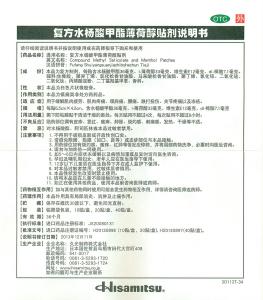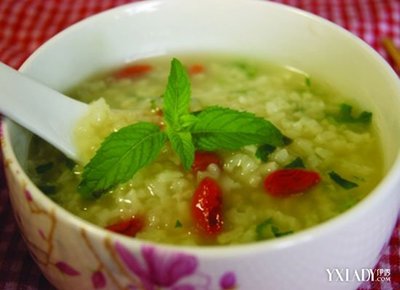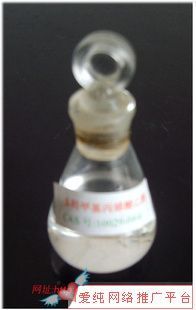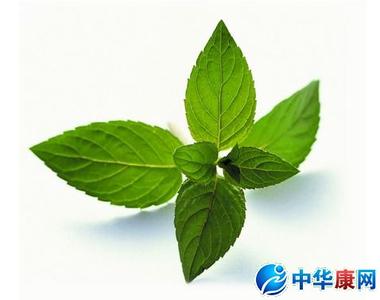薄荷醇,有机化合物,无色针状结晶或粒状,为薄荷和欧薄荷精油中的主要成分,以游离和酯的状态存在。薄荷醇有8种异构体,它们的呈香性质各不相同,左旋薄荷醇具有薄荷香气并有清凉的作用,消旋薄荷醇也有清凉作用,其他的异构体无清凉作用。可用作牙膏、香水、饮料和糖果等的赋香剂。在医药上用作刺激药,作用于皮肤或粘膜,有清凉止痒作用;内服可用于头痛及鼻、咽、喉炎症等。薄荷醇可由天然薄荷原油提纯也可用合成法制取。
薄荷醇_薄荷醇 -薄荷醇介绍
薄荷醇
一种萜,又称薄荷脑。分子式CHO,左旋薄荷醇为无色透明
针状晶体;熔点44℃ ,沸点 216.4℃,比旋光度 -48° ;微溶于水 ,溶于乙醇、乙醚 、丙酮、氯仿。 消旋薄荷醇为无色透明针状晶体;熔点 38℃, 沸点216℃; 溶于乙醇、乙醚、丙酮、苯。薄荷醇氢化生成对烷;用铬酸氧化或催化脱氢得薄荷酮;消旋薄荷醇可通过苯甲酸酯化法拆分。薄荷醇可从薄荷油分离得到,也可由香茅醛或百里酚制造。薄荷醇是一种重要香料。左旋薄荷醇由于其清凉效果,大量用于香烟、化妆品、牙膏、口香糖、甜食和药物、涂擦剂[发挥局部止痒、止痛、清凉(机理:刺激皮肤上的冷感受器但不导致实际温度变化)及轻微局麻等作用,也起促渗透剂作用]中。合成薄荷醇是各种异构体的混合物,价值不大。
薄荷醇是在叶片里制造的,也就是薄荷油的主要成分,是环类单萜的一种。是植物所产生的高挥发性精油,其成份多为半萜、单萜及倍半萜,尤其在气候温暖时产量更高。某些重要的植物色素是类萜或含类萜基的化合物。
植物来源
唇形科植物薄荷Mentho haplocalyx Bing)全草,金钱草Glechoma longituba(Nakai)Kupr.全草,尖紫苏Perilla frutescens (L.)Britt.var .Acuto(Thunb.)Kudo叶.
分子式及分子量
CHO,156.27 [CAS NO.]:89-78-1
[物理性质]白色晶体
药理作用
薄荷醇
有止痒、止痛、防腐、刺激、麻醉、清凉和抗炎作用,可治头痛、神经痛、瘙痒及呼
吸道炎症、萎缩性鼻炎、声哑等.
[Herb source]: Mentho haplocalyx Bing
[Molecular Formula]: C10H20O,
[Molecular Weight]: 156.27
[Physics Properties]:white crystal
[Pharmacology function]: itching, pain relieving and anti-corrosion and stimulating, narcotic, cool and anti-inflammatory effects, to cure a headache, neuralgia, itching and respiratory inflammation, atrophic rhinitis, signs, etc.
薄荷醇_薄荷醇 -检验
取本品叶粉末少许,经微量升华得油状物,迅速加硫酸2滴及香草醛结晶少量,显黄色至橙黄色,再加水1滴,即变紫红色。(示薄荷醇)
薄荷醇_薄荷醇 -贮藏
:密闭、避免高温及强氧化剂。
薄荷醇气相色谱
薄荷醇;薄荷脑;[1R-(1α,2β,5α)]-5-甲基-2-(1-甲基乙基)环己醇;薄荷冰;萜醇-;对烷-3-醇;[1R-(1A,2B,5A)]-5-甲基-2-(1-甲基乙基);2-异丙基-5-甲基环己醇;l-menthol;(-)-menthol;(-)-menthyl alcohol;(1r,3r,4s)-(-)-menthol;(1r-(1-alpha,2-beta,5-alpha))-5-methyl-2-(1-methyl
ethyl)cyclohexanol;(l)-menthol;(r)-(-)-menthol
资料: CAS:2216-51-5
分子式: CHO
分子质量: 156.26
沸点: 212℃
熔点: 41-43℃
中文名称: 薄荷醇;薄荷脑;[1R-(1α,2β,5α)]-5-甲基-2-(1-甲基乙基)环己醇;薄荷冰;萜醇-;对烷-3-醇;[1R-(1A,2B,5A)]-5-甲基-2-(1-甲基乙基);2-异丙基-5-甲基环己醇
英文名称: l-menthol;(-)-menthol;(-)-menthyl alcohol;(1r,3r,4s)-(-)-menthol;(1r-(1-alpha,2-beta,5-alpha))-5-methyl-2-(1-methylethyl)cyclohexanol;(l)-menthol;(r)-(-)-menthol
薄荷醇_薄荷醇 -性质
无色针状结晶或粒状。熔点41-43℃(42-45℃),沸点216.5℃,相对密度0.890(15/15℃),折光率1.458。易溶于醇;氯仿;醚;冰醋酸;液状石蜡及石油醚,微溶于水。薄荷醇含有三个不对称碳原子,已知四个空间顺式和反式异构体,它们每个都有右旋型;左旋型以及消旋型。左旋薄荷醇具有特征有薄荷香气并有清凉的作用。消旋薄荷醇([89-78-1])也有清凉作用,其它的异构体无清凉作用。
薄荷醇_薄荷醇 -生产
薄荷醇可由天然薄荷原油提纯也可用合成法制取。唇形科植物薄荷的地上部分(茎;枝;叶和花序)经水蒸气蒸馏所得的精油称薄荷原油,得油率为0.5-0.6。合成薄合脑的方法有多种。1.从香茅醛中制造 利用香茅醛易环化成异胡薄荷醇的性质,将右旋香茅醛用酸催化剂(如硅胶)环化成左旋异胡薄荷醇,分出左旋异胡薄荷醇,氢化生成左旋薄荷。其立体导师构体经热裂解可部分地遭到转变成右旋香茅醛,再循环使用。2.从百里酚中制造 在间甲酚铝存在,对间甲酚进行烷基化反应生成百里酚。经催化加氢得所有四对薄荷醇立体异构体(即消旋薄荷醇;消旋新薄荷醇;消旋异薄荷醇和消旋新异薄荷醇)。将其进行蒸馏,取消旋薄荷醇馏分,制造酯后反复重结晶,进行异构体的分离和光学拆分。分离出来的左旋薄荷醇酯,经皂化后得薄荷脑。
薄荷醇是一种重要的香料,有多种生产方法:
①从薄荷油制造:将薄荷油冷冻后析出结晶,离心所得结晶用低沸溶剂重结晶得纯左旋薄荷醇。除去结晶后的母液仍含薄荷醇40%~50%,还含较大量的薄荷酮,经氢化转变为左旋薄荷醇和右旋新薄荷醇的混合物。将酯的部分皂化,经结晶、蒸馏或制成其硼酸酯后分去薄荷油中的其他部分,可得到更多的左旋薄荷醇。
②从香茅醛制造:利用香茅醛易环化成异胡薄荷醇的性质,将右旋香茅醛用酸催化剂(如硅胶)环化成左旋异胡薄荷醇,分出左旋异胡薄荷醇,氢化生成左旋薄荷醇。其立体异构体经热裂解可部分再转变成右旋香茅醛,再循环使用。
③从百里酚制造:百里酚氢化得所有四对薄荷醇立体异构体
薄荷醇_薄荷醇 -应用
常见应用
薄荷脑和消旋薄荷脑均可用作牙膏、香水、饮料和糖果等的赋香剂。在医药上用作刺激药,作用于皮肤或粘膜,有清凉止痒作用;内服可用于头痛及鼻、咽、喉炎症等。其酯用于香料和药物。在世界上,我国和巴西是主要的天然薄荷生产国,薄荷油的年产量均达到2000-3000t。
“清凉卫生巾”及其健康争论
一些卫生巾品牌将薄荷醇等物质应用于卫生巾表面,开发出“清凉卫生巾”品种。利用此类物质的特性产生“清凉”感。但需要注意的是,敏感皮肤和过敏体质的女性,应当慎用添加香料和药物成分的卫生巾,以免引起皮肤刺激和过敏反应。
针对“清凉卫生巾”,有流言称其“破坏生殖器的弱酸环境,弱酸环境的破坏会使生殖器自身的抵抗能力下降!用了会让月经量越来越少”。但这一说法并不可靠。原因包括:
1,“清凉卫生巾”破坏阴道弱酸环境的说法在理论上有可能成立,但实际中可能较小。阴道的微生态环境的平衡对外界微生物的侵入有一定防御功能,称为阴道的自净作用。雌激素、阴道乳杆菌和阴道的弱酸性环境是构成阴道自净能力的三个重要环节。对薄荷醇的研究表明,薄荷醇本身具有一定抑菌能力,理论上在一定用量之下可能导致阴道弱酸性环境的破坏。但在实际情况中,产生凉感所需的薄荷醇浓度远小于其最低抑菌浓度,局部使用并实际进入阴道的薄荷醇难以产生抑菌效果。
2,“清凉卫生巾”也不会让月经量越来越少。首先薄荷醇并没有性激素的药理作用,不会影响内分泌,也就不会对月经产生影响。其次,子宫和阴道是相对隔离的两个环境,只在经期宫颈口会微微打开以便排出宫腔内产生的月经。因此能够从卫生巾表面扩散进入宫腔的薄荷醇等化学物质微乎其微,不可能对宫内环境造成影响。
此外,包括“清凉卫生巾”在内的一些所谓的草本卫生巾会宣传对女性有某些保健和治疗作用,这一点也不可轻信。一方面,并没有可靠的证据表明这些宣传的功效是实际有效的;另一方面,由于皮肤的结构致密,药物吸收有限,就算是在其他方面证明有效的药物,也不代表用在卫生巾上同样有效。
薄荷醇_薄荷醇 -注意
由于本品对皮肤以及眼睛有刺激作用以及一定的毒性,大量使用时必须戴好手套以及安全眼镜。
[中毒急救措施]
1、吸入:将中毒着转移至通风处,采取一般急救措施。
2、误入眼睛:按一般步骤冲洗眼睛,有必要着请咨询医师。
3、皮肤接触:用清水和肥皂清洗。
4、其他:咨询医师。
消旋薄荷醇可用蒸馏法与其他三对异构体分开,剩下的异构体混合物在百里酚氢化条件下可平衡成消旋薄荷醇、消旋新薄荷醇、消旋异薄荷醇,比例为 6:3:1,新异薄荷醇含量很少,可不计。从以上混合物可再分出消旋薄荷醇。消旋薄荷醇经苯甲酸酯饱和溶液或其超冷混合物以左旋酯接种结晶,分开后皂化,得纯左旋薄荷醇;不要的右旋薄荷醇及其他异构体,可再按氢化条件平衡转变为消旋薄荷醇。
薄荷醇_薄荷醇 -相关外文文献
下列为食品伙伴网上的关于薄荷醇(menthol)的英语资料。
Menthol is a terpenoid, found in the essential oils of the mint family (Mentha spp), such as peppermint, spearmint and others. Menthol (C10H20O) is solid at room temperature, forming long crystals that have a fatty touch. Several isomers of menthol exist, some with a menthol smell, others without. Normally occurring menthol, with the strongest smell, is (-)-menthol (lower left in figure below).
Structure of menthol and isomers
Menthol is not or poorly soluble in water, but readily soluble in alcohol or oils.
Besides the use as an aroma in many different food products (especially dental products, such as chewing gum, cough drops and confectionary, such as mints), menthol is contained in non-prescription products for short-term relief of minor sore throat and minor mouth or throat irritation, for example in lip balms and cough medicines. It is classed as an antipruritic, which reduces itching. Menthol is also contained in combination products used for relief of muscle aches, sprains, and similar conditions, as well as in decongestants. In addition, it is used as an additive in certain cigarette brands, both for flavour and to reduce the throat and sinus irritation caused by smoking. Menthol also is a common ingredient in mouthwash.
Menthol
From Wikipedia, the free encyclopedia
Jump to: navigation, search
Not to be confused with methanol.
Menthol
General
Systematic name 2-(2-Propyl)-5-
methylcyclohexanol
Stereochemical
configuration (2S,5R,1R)
Other names 3-p-Menthanol,
Hexahydrothymol,
Menthomenthol,
peppermint camphor
Molecular formula C10H20O
SMILES CC1CCC(C(C1)O)C(C)C
Molar mass 156.27?g・mol?1
Appearance White or colorless
crystalline solid
CAS number [89-78-1], racemic
[2216-51-5], (?)-isomer
Properties
Density and phase 0.890?g・cm?3, solid
(racemic or (?)-isomer)
Solubility in water Slightly soluble, (?)-isomer
In ethanol, diethyl ether,
acetone, chloroform
acetic acid, hexane Soluble
Melting point 36-38?°C (311?K), racemic
42-45?°C (318?K), (?)-form (α)
35-33-31?°C, (?)-isomer
Boiling point 212?°C (485?K)
Chiral rotation [α]D -50° at 18 °C, 10% in EtOH
Hazards
MSDS External MSDS
Main hazards Irritant, flammable
NFPA 704 210
Flash point 93?°C
R/S statement R37/38, R41 S26, S36
RTECS number OT0350000, racemic
OT0700000, (?)-enantiomer
Supplementary data page
Structure & properties n, εr, etc.
Thermodynamic data Phase behavior
Solid, liquid, gas
Spectral data UV, IR, NMR, MS
Related compounds
Related alcohols Cyclohexanol, Pulegol,
Dihydrocarveol, Piperitol
Related compounds Menthone, Menthene,
Thymol, p-Cymene,
Citronellal
Except where noted otherwise, data are given for
materials in their standard state (at 25?°C, 100?kPa)
Infobox disclaimer and references
Menthol is a covalent organic compound made synthetically or obtained from peppermint or other mint oils. It is a waxy, crystalline substance, clear or white in color, which is solid at room temperature and melts slightly above. The main form of menthol occurring in nature is (-)-menthol, which is assigned the (1R,2S,5R) configuration. Menthol has local anesthetic and counterirritant qualities, and it is widely used to relieve minor throat irritation.
Contents [hide]
1 History and occurrence
2 Structure
3 Applications
4 Synthesis
5 Natural menthol
6 Chemical properties
7 Biological properties
8 Notes
9 References
History and occurrence
There is evidence that menthol has been known in Japan for more than 2000 years, but in the West it was not isolated until 1771, by Gambius. (-)-Menthol (also called l-menthol or (1R,2S,5R)-menthol) occurs naturally in peppermint oil (along with a little menthone, the ester menthyl acetate and other compounds), obtained from mentha x piperita. Japanese menthol also contains a small percentage of the 1-epimer, (+)-neomenthol.
Structure
Natural menthol exists as one pure enantiomer, nearly always the (1R,2S,5R) form (bottom left of diagram below).
In the natural compound, the isopropyl group is oriented trans- orientation to both the methyl and alcohol groups.
In the ground state all three bulky groups in the chair are equatorial, making (-)-menthol and its enantiomer the most stable two isomers out of the eight.

There are two crystal forms for racemic menthol; these have melting points of 28?°C and 38?°C. Pure (-)-menthol has four crystal forms, of which the most stable is the α form, the familiar broad needles.
Applications
Menthol is included in many products for a variety of reasons. These include:
In non-prescription products for short-term relief of minor sore throat and minor mouth or throat irritation
Examples: lip balms and cough medicines
As an antipruritic to reduce itching
As a topical analgesic to relieve minor aches and pains such as muscle cramps, sprains, headaches and similar conditions, alone or combined with products like Camphor or Capsaicin. In Europe it tends to appear as a gel or a cream, while in the US patches and body sleeves are very frequently used
Examples: Tiger Balm IcyHot patches or knee/elbow sleeves
In decongestants for chest and sinuses (cream, patch or nose inhaler)
Examples: Vicks Vaporub
In certain medications used to treat sunburns, as it provides a cooling sensation (then often associated with Aloe)
As an additive in certain cigarette brands, for flavor, to reduce the throat and sinus irritation caused by smoking and arguably to reduce the bad-breath smokers experience and possibly improve the smell of second-hand smoke.
Commonly used in oral hygiene products and bad-breath remedies like mouthwash, toothpaste, mouth and tongue-spray, and more generally as a food flavor agent e.g. in chewing-gum, candy
In a soda as well as in a syrup to be mixed with water to obtain a very low alcohol drink or (brand Riclès in France). The syrup is/was also used to alleviate nausea, in particular motion sickness, by pouring a few drops on a lump of sugar.
As a pesticide against tracheal mites of honeybees
In perfumery, menthol is used to prepare menthyl esters to emphasise floral notes (especially rose)
In first aid products such as "mineral ice" to produce a cooling effect as a substitute for real ice in the absence of water or electricity (Pouch, Body patch/sleeve or cream)
In various patches ranging from fever-reducing patches applied to children's foreheads to "foot patches" to relieve numerous ailments (the latter being much more frequent and elaborate in Asia, esp. Japan: some variety use `functional protrusion' i.e. small bumps to massage ones feet as well as soothing them and cooling them down)
In some beauty products such as hair-conditioners, based on natural ingredients (ex: St Ives)
Some supporters of the homeopathic theory of pharmacology believe that menthol interferes with the effects of homeopathic remedies. Its use is strongly discouraged for those seeking homeopathic cures, to the point of prohibiting the use of mint-flavored toothpaste. Currently no other reported nutrient or herb interactions involve menthol. It is used in Eastern medicine to treat indigestion, nausea, sore throat, diarrhea, colds, and headaches. (-)-Menthol has low toxicity: Oral (rat) LD50: 3300?mg・kg?1; Skin (rabbit) LD50: 15800?mg・kg?1).
In organic chemistry, menthol is used as a chiral auxiliary in asymmetric synthesis. For example, sulfinate esters made from sulfinyl chlorides and menthol can be used to make enantiomerically pure sulfoxides by reaction with organolithium reagents or Grignard reagents. Menthol is also used for classical resolution of chiral carboxylic acids, via the menthyl esters.
Synthesis
As with many widely-used natural products, the demand for menthol greatly exceeds the supply from natural sources. Menthol is manufactured as a single enantiomer (94% ee) by Takasago International Co. on a scale of 400?000 tonnes per year. The process involves an asymmetric synthesis developed by a team led by Ryoji Noyori.
The process begins by forming an allylic amine from myrcene, which undergoes asymmetric isomerisation in the presence of a BINAP rhodium complex to give (after hydrolysis) enantiomerically pure R-citronellal. This is cyclised by a carbonyl-ene-reaction initiated by zinc bromide to isopulegol which is then hydrogenated to give pure (1R,2S,5R)-menthol.
Racemic menthol can be prepared simply by hydrogenation of thymol, and menthol is also formed by hydrogenation of pulegone. For preparation of other isomers such as neomenthol, see ref. 1.
Natural menthol
Mentha arvensis is the primary species of mint used to make natural menthol crystals and natural menthol flakes. This species is primarily grown in the Uttar Pradesh region in India.
Chemical properties
Menthol reacts in many ways like a normal secondary alcohol. It is oxidised to menthone by oxidising agents such as chromic acid, though under some conditions the oxidation can go further and break open the ring. Menthol is easily dehydrated to give mainly 3-menthene, by the action of 2% sulfuric acid. PCl5 gives menthyl chloride.
Biological properties
Menthol's ability to chemically trigger cold-sensitive receptors in the skin is responsible for the well known cooling sensation that it provokes when inhaled, eaten, or applied to the skin. Menthol does not cause an actual drop in temperature. In this sense it is similar to capsaicin, the chemical responsible for the spiciness of hot peppers (which stimulates heat sensors, also without causing actual temperature rise).
Notes
^ J. L. Simonsen, The Terpenes Volume I (2nd edition), Cambridge University Press, 1947, p230-249.
^ Adversoriorum varii argumentii, Liber unus, Leiden, 1771, p99.
^ R. Eccles, Menthol and Related Cooling Compounds, Journal of Pharm. Pharmacol. 1994 46: 618-630
References
E. E. Turner, M. M. Harris, Organic Chemistry, Longmans, Green & Co., London, 1952.
Handbook of Chemistry and Physics, 71st edition, CRC Press, Ann Arbor, Michigan, 1990.
The Merck Index, 7th edition, Merck & Co, Rahway, New Jersey, USA, 1960.
 爱华网
爱华网



